i. the text of light
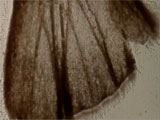 The filmmaker Stan Brakhage is one of those people whose work hangs in the back of my mind with a frequency well out of proportion to my actually engaging with his work. I first (and really, only, until recently) saw his films about seven years ago, when he introduced a marathon screening of what must have been almost his complete works. Hours later, I stumbled out of the theatre, knowing that this was someone whose work I should have seen years before, having seen on the screen something new to me, a new way of looking at the possibility of film. I’ve felt an analogous sensation with only a handful of artists and writers; I’ve found it again in the luminously fractured English of Amos Tutuola, Ray Johnson’s conceptual games of “correspondance”, and Michel Butor’s reimagining of the page and narrative.
The filmmaker Stan Brakhage is one of those people whose work hangs in the back of my mind with a frequency well out of proportion to my actually engaging with his work. I first (and really, only, until recently) saw his films about seven years ago, when he introduced a marathon screening of what must have been almost his complete works. Hours later, I stumbled out of the theatre, knowing that this was someone whose work I should have seen years before, having seen on the screen something new to me, a new way of looking at the possibility of film. I’ve felt an analogous sensation with only a handful of artists and writers; I’ve found it again in the luminously fractured English of Amos Tutuola, Ray Johnson’s conceptual games of “correspondance”, and Michel Butor’s reimagining of the page and narrative.
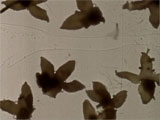 But Brakhage. His films tend to be short and silent. His editing, if it can be called such, is quick – often an image only shows for a frame, then it’s gone. In most of his films, he cuts quickly between shots; in some of his work he abandoned the camera entirely to work directly with the film stock itself, painting on it or gluing things to it. Jean-Luc Godard said that the cinema was the truth twenty-four times a second; rarely has this been so literally explicated as in Brakhage’s films. Mitchell Stephens, in The Rise of the Image, the Fall of the Word saw in the lighting-fast editing style that Brakhage introduced a possible future for communication. But Brakhage was following his own very particular muse. His aim, he declared in one of his later films, was to show on film what the eye sees when it is closed, the phenomenon of dancing spots of color that’s been termed hypnogogic vision.
But Brakhage. His films tend to be short and silent. His editing, if it can be called such, is quick – often an image only shows for a frame, then it’s gone. In most of his films, he cuts quickly between shots; in some of his work he abandoned the camera entirely to work directly with the film stock itself, painting on it or gluing things to it. Jean-Luc Godard said that the cinema was the truth twenty-four times a second; rarely has this been so literally explicated as in Brakhage’s films. Mitchell Stephens, in The Rise of the Image, the Fall of the Word saw in the lighting-fast editing style that Brakhage introduced a possible future for communication. But Brakhage was following his own very particular muse. His aim, he declared in one of his later films, was to show on film what the eye sees when it is closed, the phenomenon of dancing spots of color that’s been termed hypnogogic vision.
 Mothlight, stills from which can be seen floating about this post, was one of the films that stuck most clearly in my mind. In it, Brakhage set out to show “what a moth might see from birth to death if black were white and white were black.” The ratio of the size of the moth to that of ourselves is roughly that of the size of a film negative to the blown up film; with this in mind, and a collection of dead moths that had flown into a light and perished, Brakhage composed a three-minute film, every frame of which is composed of things from the moth’s world: wings, plant leaves, and flowers. Brakhage pasted these objects directly onto the film stock. When the film is projected there’s a rush of images made unfamiliar by size: a moth wing or a flower twenty feet wide is something we’ve never seen before. Though constructed of objects that we imagine we know, the moth’s world as Brakhage depicts it is utterly foreign to us. Speed has a lot to do with it: the eye can’t possibly process twenty-four different images per second. The moth’s world is much faster than our own.
Mothlight, stills from which can be seen floating about this post, was one of the films that stuck most clearly in my mind. In it, Brakhage set out to show “what a moth might see from birth to death if black were white and white were black.” The ratio of the size of the moth to that of ourselves is roughly that of the size of a film negative to the blown up film; with this in mind, and a collection of dead moths that had flown into a light and perished, Brakhage composed a three-minute film, every frame of which is composed of things from the moth’s world: wings, plant leaves, and flowers. Brakhage pasted these objects directly onto the film stock. When the film is projected there’s a rush of images made unfamiliar by size: a moth wing or a flower twenty feet wide is something we’ve never seen before. Though constructed of objects that we imagine we know, the moth’s world as Brakhage depicts it is utterly foreign to us. Speed has a lot to do with it: the eye can’t possibly process twenty-four different images per second. The moth’s world is much faster than our own.
The memory of that flicker of images has stayed with me, as much for its ephemerality as anything else: I’d seen something briefly, not long enough to remember the images themselves, but long enough to remember the film more clearly than nearly anything else I saw that year.
ii. the act of seeing with one’s own eyes
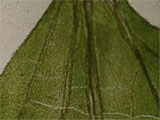 The Criterion Collection released a two-DVD set of some of Brakhage’s films a few years ago, a year or so before he passed away and was briefly in the news again. I’m not sure why I held off buying a copy of the DVD: maybe a devotion to the ephemerality of memory? I did convince an old roommate, a painter, to buy his own copy soon after it was released: independently, he had been trying to capture with oils hypnogogic visions of his own. But I didn’t get a copy until a few weeks ago, when after finding him again in Mitchell Stephens’s book, I broke down for an online Christmas DVD sale. It arrived, and I inserted one of the discs into my Powerbook, curious to see how his films compared to my memory of them.
The Criterion Collection released a two-DVD set of some of Brakhage’s films a few years ago, a year or so before he passed away and was briefly in the news again. I’m not sure why I held off buying a copy of the DVD: maybe a devotion to the ephemerality of memory? I did convince an old roommate, a painter, to buy his own copy soon after it was released: independently, he had been trying to capture with oils hypnogogic visions of his own. But I didn’t get a copy until a few weeks ago, when after finding him again in Mitchell Stephens’s book, I broke down for an online Christmas DVD sale. It arrived, and I inserted one of the discs into my Powerbook, curious to see how his films compared to my memory of them.
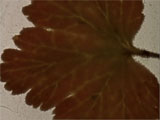 Watching him the first time, I’d been supine before the screen. Watching him on my laptop was something different, something surprising. My first impulse after starting one of the films playing was the obvious one when something’s going too fast, but not an option that one has when you’re part of an audience: to hit the pause button. The moth wings, spider webs, flowers, and blades of grass instantly snap into startling focus: around every object, you can see the halo of glue that Brakhage used to hold it to the celluloid. Then another pleasant surprise: on the Apple DVD player, if you then press the right arrow button, you can advance one frame. Not another frame in the same shot, as one would expect in an ordinary film, but another image entirely, though sometimes, you realize, a connected object: in some frames one sees the top of a plant leaf, in the following, the bottom, exactly as Brakhage constructed the film. (Images of the film stock itself – not just screencaptures from the DVD – can be seen at critic Fred Camper’s website, which offers a dizzying amount of information on Stan Brakhage.)
Watching him the first time, I’d been supine before the screen. Watching him on my laptop was something different, something surprising. My first impulse after starting one of the films playing was the obvious one when something’s going too fast, but not an option that one has when you’re part of an audience: to hit the pause button. The moth wings, spider webs, flowers, and blades of grass instantly snap into startling focus: around every object, you can see the halo of glue that Brakhage used to hold it to the celluloid. Then another pleasant surprise: on the Apple DVD player, if you then press the right arrow button, you can advance one frame. Not another frame in the same shot, as one would expect in an ordinary film, but another image entirely, though sometimes, you realize, a connected object: in some frames one sees the top of a plant leaf, in the following, the bottom, exactly as Brakhage constructed the film. (Images of the film stock itself – not just screencaptures from the DVD – can be seen at critic Fred Camper’s website, which offers a dizzying amount of information on Stan Brakhage.)
Technically, this is not very exciting at all: pausing to see a crisp frame is just one of the niceties of the DVD that we’re all used to. But what this does to the viewer’s experience of the film is immeasurable. Instead of the imposed stricture of watching the images projected at 24 frames per second, you’re free to proceed through Brakhage’s frames at any rate you like – his film becomes something like a slide show. As great a change, though, is imparted to the viewer, who goes from being a passive recipient of speeding images to an active participant with control over what’s being shown.
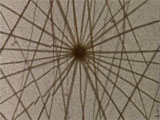 This isn’t, it’s worth pausing to consider, something that would have been possible with a VHS tape. Video didn’t respect the frames of film, and a paused VHS tape generally gives you a blurred and indistinct image. Presumably with a projector and a copy of the original films, you could do the same thing. (This would also resolve the incongruity of looking at images that are meant to have light projected through them rather than being composed of red, green, and blue blips of it, as on my computer screen.) Alas, not many of us have our own movie theater to try this out in. For the rest of us, this amount of control is something that arrives with new digital media, and deserves to be considered as a function of it.
This isn’t, it’s worth pausing to consider, something that would have been possible with a VHS tape. Video didn’t respect the frames of film, and a paused VHS tape generally gives you a blurred and indistinct image. Presumably with a projector and a copy of the original films, you could do the same thing. (This would also resolve the incongruity of looking at images that are meant to have light projected through them rather than being composed of red, green, and blue blips of it, as on my computer screen.) Alas, not many of us have our own movie theater to try this out in. For the rest of us, this amount of control is something that arrives with new digital media, and deserves to be considered as a function of it.
From time to time, Bob talks to the programmers busy making Sophie about imagining film as being a book that’s flipping through 86,400 pages per hour. This sort of talk tends to throw them into conniptions (to paraphrase: nobody in their right mind thinks that way & how current processors don’t have nearly enough computational power and they probably won’t for the next fifty years). But despite their objections, that’s almost exactly what we have here, if not through design. It’s worth noting, of course, that the tools for reading film in this way aren’t yet perfect: while I can press the right arrow to advance a frame in my DVD player, I can’t, for some reason, press the left arrow to go back a frame: you have to rewind. I can’t look at several consecutive frames together without a fair amount of work. There’s more work for the programmers.
iii. mothlight
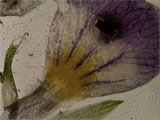 Thinking about technology for the past month or so, I’ve often found myself in a mild funk, which might be the sort of thing one expects to set in around the end of the year, when I, at least, find myself wanting to neatly box the disjointed events of the past year to take up to the attic for storage. The crux of my worrying: while there’s clearly no shortage for ideas of new ways to say things – as even a cursory reading of this blog will readily attest – there seems to be a comparative paucity of new ways to understand things. Maybe this makes sense: people like novelty. It’s more exciting to announce something brand new and different than to find a new way to look at something familiar. Who can be bothered to care about a fourteenth way of looking at a blackbird when you can make your own genetically-modified fuchsia- and chartreuse-birds?
Thinking about technology for the past month or so, I’ve often found myself in a mild funk, which might be the sort of thing one expects to set in around the end of the year, when I, at least, find myself wanting to neatly box the disjointed events of the past year to take up to the attic for storage. The crux of my worrying: while there’s clearly no shortage for ideas of new ways to say things – as even a cursory reading of this blog will readily attest – there seems to be a comparative paucity of new ways to understand things. Maybe this makes sense: people like novelty. It’s more exciting to announce something brand new and different than to find a new way to look at something familiar. Who can be bothered to care about a fourteenth way of looking at a blackbird when you can make your own genetically-modified fuchsia- and chartreuse-birds?
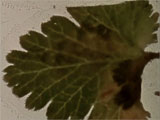 My funk wasn’t straight misoneism: I’m all for new forms else I wouldn’t be working here. But if we’re to create new forms that resonate as strongly as the physical book has been able to historically – a project that I suspect Brakhage considered himself engaged in – it’s just as important to find new ways to understand how what we’ve created works. And this is I think why the simple gesture of hitting the “pause” button in the middle of a film feels like something of a revelation to me, puncturing my December miasma. It’s not a blinding Damascene conversion, and that’s perhaps the point: it’s a realization that there are plenty of possibilities for new ways to look at things. We just need to notice them.
My funk wasn’t straight misoneism: I’m all for new forms else I wouldn’t be working here. But if we’re to create new forms that resonate as strongly as the physical book has been able to historically – a project that I suspect Brakhage considered himself engaged in – it’s just as important to find new ways to understand how what we’ve created works. And this is I think why the simple gesture of hitting the “pause” button in the middle of a film feels like something of a revelation to me, puncturing my December miasma. It’s not a blinding Damascene conversion, and that’s perhaps the point: it’s a realization that there are plenty of possibilities for new ways to look at things. We just need to notice them.
The late Guy Davenport, one of Brakhage’s friends and a kindred spirit, defended the unity of some of his own work – short stories that included his own drawings as an integral part of the story – by arguing that text, picture, and film weren’t in opposition, but were all images alike:
“A page, which I think of as a picture, is essentially a texture of images. . . . The text of a story is therefore a continuous graph, kin to the imagist poem, to a collage (Ernst, Willi Baumeister, El Lissitzky), a page of Pound, a Brakhage film.”
(from “Ernst Machs Max Ernst”, pp. 374-5 in The Geography of the Imagination)
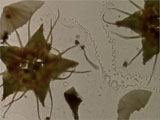 Davenport’s declaration can be turned inside-out: we can now take a Brakhage film and read it as a series of pages. The word and the image still aren’t quite the same thing, but digital media allows us to think about them in some of the same ways. Watching with the pause button ready, we can scrutinize the composition of a single frame of film just as you might scrutinize an individual line or words in a poem, a page of a book.
Davenport’s declaration can be turned inside-out: we can now take a Brakhage film and read it as a series of pages. The word and the image still aren’t quite the same thing, but digital media allows us to think about them in some of the same ways. Watching with the pause button ready, we can scrutinize the composition of a single frame of film just as you might scrutinize an individual line or words in a poem, a page of a book.
Or again: historically, the coming of the book might be seen as freeing the reader from the dominion of time. The pre-literate can only listen to a text being read, while the literate is free to read at leisure. It’s a pause button, of a sort. Brakhage’s moth seems an apt tool for thinking here. I haven’t done the math, but I’d imagine the ratio of the length of a moth’s life to our own is about the same as the ratio of the moth’s size to our own. When we look at a moth, we see a being utterly bound by time. But it doesn’t have to be that way.

wow! dan, thanks for a really interesting post — on so many levels. mostly it’s got me thinking about how the interactive media landscape has changed in the 25 years since i first got involved. in 1980 we had analog videodiscs (the big silver discs) and at the beginning the medium was all about stopping, starting, slow-motion and still-step in both directions. there were a zillion experiments about new ways of capturing, presenting and most importantly of seeing. when the first feature films were released on videodisc they were encoded so that you could freeze frame at any time or go into slow-motion or still-step. unfortunately that mode was more expensive to produce and was limited to 30 min per side forcing viewers to turn the disc over 3 or 4 times. cost and convenience led the studios to release films in a format which yielded 60 minutes per side but lost us the ability to control the presentation in any interesting way. this shift and the overall failure of videodiscs to catch on pretty much ended the wave of experimentation. not sure why it hasn’t picked up again with DVDs. will write a post about one of my favorite experiments we did at Voyager — The LA Journal.
A small point:
“… a marathon screening of what must have been almost his complete works. Hours later, I stumbled out of the theatre …”
I think you meant either “a mere fraction of” or “Days later” … given that the work in distribution totals something like 70 hours of running time 😉
A larger point:
What you see when you flip through a Brakhage film a frame at a time ceases to be a Brakhage film; the experience that was created for the theatre incorporated the phi effect, so what you saw was not a series of very quick images, but a rolling composite. Scrutinizing the individual frames is not so analogous to scrutinizing and individual line of text, as it is to scrutinizing a series of letters (paying particular attention to the serifs!).
Mr. Flannery – no one will ever mistake me for any sort of authority on film, least of all on Brakhage’s. Point taken w/r/t the complete works – it was six hours or so, but not seventy.
I’ll agree that looking through the frames individually ceases to be a Brakhage film – certainly, it ceases to be a Brakhage film as he originally intended them to be seen, although, as he was involved in the creation of the Criterion DVD, he must have been aware that there was the potential for them to be looked at like this. I’m not sure, however, that I’d go so far as your analogy to type. For one thing, there are very few documents where the writer has also created the type. Even when that’s the case, the relation of type to what’s composed in it is very different to the relationship between Brakhage’s individually composed frames and the film as a whole – the alphabet is abstract in a way that Brakhage’s individual images are not.
What can be gained from this, I think, is that we can’t use preconceived metaphors – film doesn’t break down into the same sort of semantic units that text can be broken into. There is a new way of reading that’s available here, but it’s something entirely different.
Oh wait – the obvious comparison that I completely missed was handwriting, which could be scrutinized in a way that type usually can’t. Whether that scrutiny is useful or not is of course another question.
I enjoyed your thoughts on brakhage. I’d been thinking about him a lot for a month or so while playing with gifs. I’m always hoping that people freeze some of my animations by clicking on the scroll bar, because often frames are their own self contained composition. One of the things I’m convinced about, is that the play of still and moving images will become a very important part of reading and writing digital texts. Your essay points at ways that texts can be experienced in several ways… I’d been thinking about making a short text film (maybe moby dick) where it would dance on screen as an abstract grid image, but if taken frame by frame would still be the text in order…
freezing the frame is nice, but not a film-nor a book (like flicking through a book is nice-but not a book, or a film). the inherent qualities in any single frame may well achieve a state worth studying in isolation, but that is as much a by product of the work itself as a perceived sense of rhythmic movement through the flicking of pages in a book due to the gaps between words (sentences, paragraphs, chapters) would be.
to take brakhage’s work and slow it, thereby making a new piece of work: or to take each frame and make a book: or to take a single image and make it immense: or to lay every frame one upon the other to create a single image of the whole work . . . perhaps all valid . . . and much more. there is no shortage of ways to understand things.
also, the analogy of type is reasonably valid . . . there are few filmakers who have created a moth, for example. i think the main thing here is, to rephrase the response: we can’t use preconceived metaphors – a film doesn’t break down into units.
notwithstanding the chance that many frames of film just don’t bear scrutiny.
and . . . with the notion of ‘a new way of reading’ . . . absolutely valid; every new thing is a new thing if one hasn’t experienced it . . . and then it’s a question of what one does about that.
There’s an interesting discussion of this on a site I found a week or two ago, BLDGBLOG. If you cast light through just about anything could you make a film? And what does this say about landscapes, insects, other organisms? Are there films inside everything? On that level, if you’re analyzing cells, frames, individual moments of a film, you find everything is a film – or a book, as you’re discussing. So maybe I disagree that a film doesn’t break down into units? Because everything contains sections; and each section can be a frame in a larger film.
film flows: in itself, it is like the wind-or, it is light. the human mind assigns units to everything (like time), but try to make a unit of the river at this point here in front of you while watching from the bank as it flows on: or, the question of what and how we can percieve opposed to what is- i.e. the limitations of our senses (which drives the desire to ‘break into units’).
it is the artifice of film that allows for its objectification (breaking into units), but the dreamlife of film is something other . . . light is already cast through everything (or we couldn’t see) but then it’s about whether and how and to what you want to fix it. obviously in terms of the physical then one can break anything down-the moth’s wing, the two parts of the wing, the scales on the wing, the cells . . . but then what do we find? it can no longer fly . . .
then, with slowness and seeing and hearing-things like the 24 hour psycho, or eno’s ‘discreet music’, la jetee, w.g. sebald, iain sinclair and on and on.
if a medium or a work is unsatisying because it does not conform to ones desires, then the answer is to make for oneself what one desires.
then i think it’s somewhere between gaming, generative/reactive, and the web-gaming is closest but
still not as strong as film as film, book as book etc.
What about a film using moths – while they’re flying? The cloud of wings moves in front of the projector. The film begins.